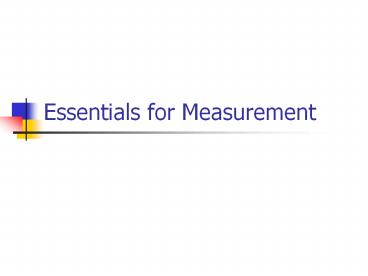Essentials for Measurement - PowerPoint PPT Presentation
Title:
Essentials for Measurement
Description:
Essentials for Measurement Basic requirements for measuring The reduction of experience to a one dimensional abstraction. More or less comparisons among persons and ... – PowerPoint PPT presentation
Number of Views:123
Avg rating:3.0/5.0
Title: Essentials for Measurement
1
Essentials for Measurement
2
Basic requirements for measuring
- The reduction of experience to a one dimensional
abstraction. - More or less comparisons among persons and items.
- The idea of linear magnitude inherent in
positioning objects along a line. - A unit determined by a process which can be
repeated without modification over the range of
the variable.
3
Lets consider weight
- At some point, weight was constructed why?
- Is it one dimensional?
- Can we make comparisons of more and less?
- Does it have linear magnitude?
(1 lb 1 lb 2 lbs?) - Do we have a process to determine weight which we
can repeat without modification over the range of
the variable?
4
Social science measures should follow the same
criteria
- Just like weight, height, time and temperature
are measured with universally useful
instruments, our task is to devise instruments to
measure variables in the human sciences. - Psychometrics is often more about the psycho
and less about the metrics. - Rasch modeling does not replace or supercede
statistical analyses it should precede it.
5
We start by searching for the possibility of order
- Amount of an attribute in a person vs. amount
in another person - Amount in an item vs. amount of that
attribute in another item - Can we level items such that endorsing the next
item indicates more of the attribute in the
person?
6
The Rasch model is probabilistic
- Guttmans idea
- If you endorse an extreme statement, you will
endorse ALL less extreme statements. This makes a
scale. - With Rasch
- If you endorse an extreme statement, there is a
good probability that you will endorse all less
extreme statements.
7
Objectivity
- Values should have similar meaning over time and
place. - The measure (set of items) assigned to the
construct must be independent of the person
taking these items. - Does the weight of 1 pound on a scale depend on
what a person is measuring? - Should the difficulty of an item depend on the
distribution of abilities of persons responding
to the item?
8
Conjoint Additivity
- To be additive, units must be identical.
- Are apples additive?
- 1 Apple 1 Apple 2 Apples.
- But 2 Apples are twice as much as 1 Apple only
when the 2 Apples are perfectly identical. - Real apples are not!
- Rasch measurement forms an equal interval linear
scale, just like weight.
9
Conjoint Additivity
- When any pair of measurements have been made with
respect to the same origin on the same scale, the
difference between them is obtained merely by
subtraction. - Rasch measurement creates a single person/item
yardstick with person ability (Bn) estimated in
conjunction with item difficulty (Di). - Bn-Di gt 0, Probability the person will answer
correctly (Pxni)gt .05. - Bn-Di lt 0, Pxni lt .05.
- Bn-Di 0, Pxn .05.
10
Fit to the model
- Fit statistics indicate where the principles of
probabilistic conjoint measurement have been
sufficiently satisfied to justify the claim that
results can be used as a scale with interval
measurement properties.
11
Rasch unit for counting a logit
- Logit A Log-Odds Unit
- Transformation of the raw score scale (ordinal)
into an interval scale - The raw score percentage is converted into its
success-to-failure ratio - The logarithm of this score is taken
- In this way, the bounded outcome of probabilities
(ogive) is straightened.
12
What is a success-to-failure ratio?































